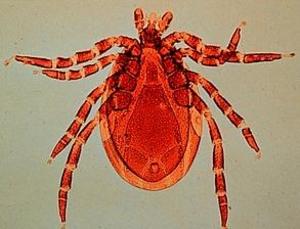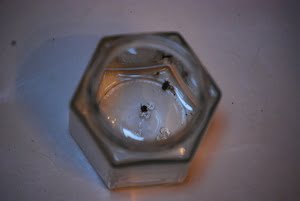Lyme disease was first described and named at Yale University in the mid 1970s. In 1975, large numbers of children were coming down with what appeared to be juvenile rheumatoid arthritis, at an incomprehensible rate; these symptoms were caused by what became known as Lyme disease. Deer ticks, infected by a bacterium known as Borrelia burgdorferi, transmit Lyme disease through their bite. Found mostly in the Northeast, the Midwest, and Northern California, Lyme disease displays symptoms that closely resemble arthritis if undetected or left untreated.
Deer ticks are minute, about the size of the head of a pin, and their brown color makes them hard to see. When they bite a human being, they can secrete a substance that makes the person feel no pain or itching, so that they go unnoticed.
Researchers used to think that for the Lyme disease bacteria to be transmitted to a person, a deer tick had to be attached for as long as two days, but recent studies indicate it may take as little as a few hours for the process to be completed. The disease takes it name from the town in Connecticut where the children were being infected, Old Lyme, and although the disease has spread across the nation, a majority of the cases reported are limited to the Nutmeg State and New York.
It is suspected that Lyme disease is grossly under-reported and misdiagnosed, as its symptoms bear close resemblance to other diseases. All Lyme disease sufferers do not experience the same symptoms in a uniform way, which adds to the confusion. But they can usually expect for a small red bump to form where they were bitten by the tick. This can happen as quickly as a couple of days after, or as long as a month. The bump can be warm to the touch and tender, and will expand in time to be dime size or as large as twelve inches in diameter. The rash can look like a target’s “bull’s eye”, a red ring that surrounds a clear area with a reddish middle. Eighty percent of those infected with Lyme disease will develop this rash, known as erythema migrans. The sufferer can also have a fever, chills, become easily tired, and have headaches and muscle pain. Left untreated, Lyme disease can precipitate severe joint pain, for months after the original infection. In rare cases, nervous system troubles arise, conditions such as Bell’s palsy, numbness in the limbs, and limited muscle control. These can occur years after the tick has bitten you, and can lead to memory loss, a hard time sleeping, and mood changes.
Luckily for outdoorsman and those that venture into areas where deer ticks are plentiful, only a very small percentage of tick bites result in Lyme disease. The longer the tick is attached, the better the chances of it being able to transmit the malady. If you know that you have been bitten and begin to show Lyme disease symptoms, it is imperative to see a doctor. If at all possible, bring the tick with you. Lyme disease treatment is most effective if begun in the very early stages of the disease. Just because you don’t exhibit all the symptoms, be aware that they can manifest themselves months after the first contact. Your physician has a number of tests that can be performed to determine Lyme disease, especially if the rash never shows up but the other symptoms do. Because of the number of other diseases that share these symptoms, it is important for your doctor to make an accurate diagnosis before deciding on a course of action.
The use of oral antibiotics for fighting the effects of early Lyme disease include the prescribing of doxycycline for adults and kids over eight years old and amoxicillin for adults and younger children. If the disease is further along, your doctor will most likely make use of intravenous antibiotics for a few weeks. The drug bismacine, an injectable that some alternative medicine physicians use to battle this disorder, has been linked to heart and kidney failure by the Food and Drug Administration and should not be used against Lyme disease. Lyme disease can be cured by antibiotics if caught in time; if not, the symptoms are dealt with. Painkillers such as ibuprofen, and anti-inflammatory medications for joint pain, are most effective in reducing the discomfort that Lyme disease in its later stages can bring.
To prevent a case of Lyme disease, wear the proper clothing when you go out into grassy or wooded areas. Long pants and long sleeves are prudent, and avoid going off the beaten path if you can. Look for ticks on your kids and yourself when you come in from these high-risk areas. If you find one, remove it with a pair of tweezers, gently and without crushing it. Grasp it by its head or mouth and slowly pull it out; be sure to apply an antiseptic to the area once the tick has been successfully removed. Your pets can also contract a form of Lyme disease, so be sure to check them regularly for ticks and keep them out of the woods or close to you on a leash. Insect repellants with a ten to thirty percent level of concentration of DEET can ward off deer ticks when applied properly. Keep your backyard free of brush and leaves and high grass, places where these ticks can flourish. A Lyme disease vaccine was developed, but distribution halted in 2002 when its safety and effectiveness came under fire. Now that hunting season is here, coupled with families venturing out to procure a Christmas tree for the holiday, it is most advisable to be aware of the dangers of Lyme disease.



